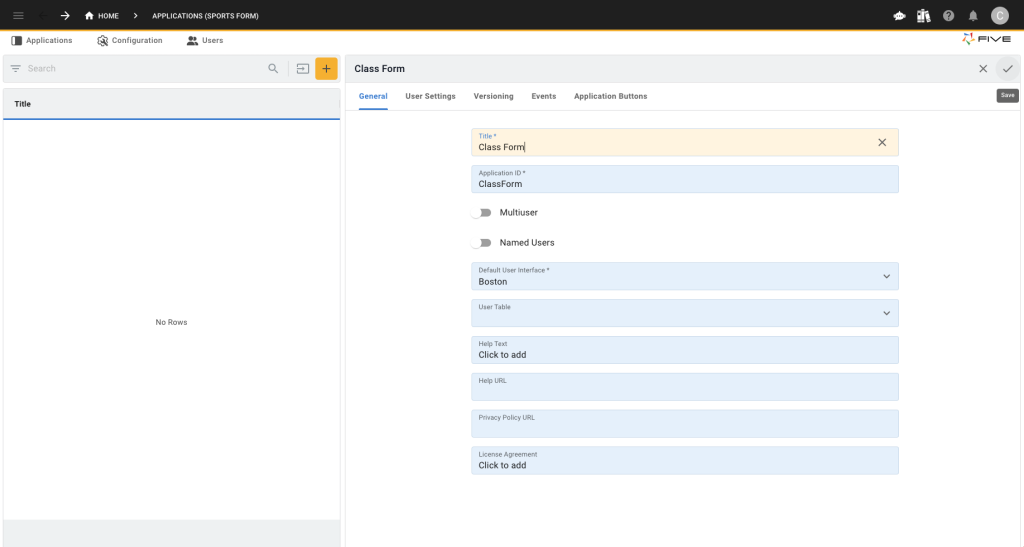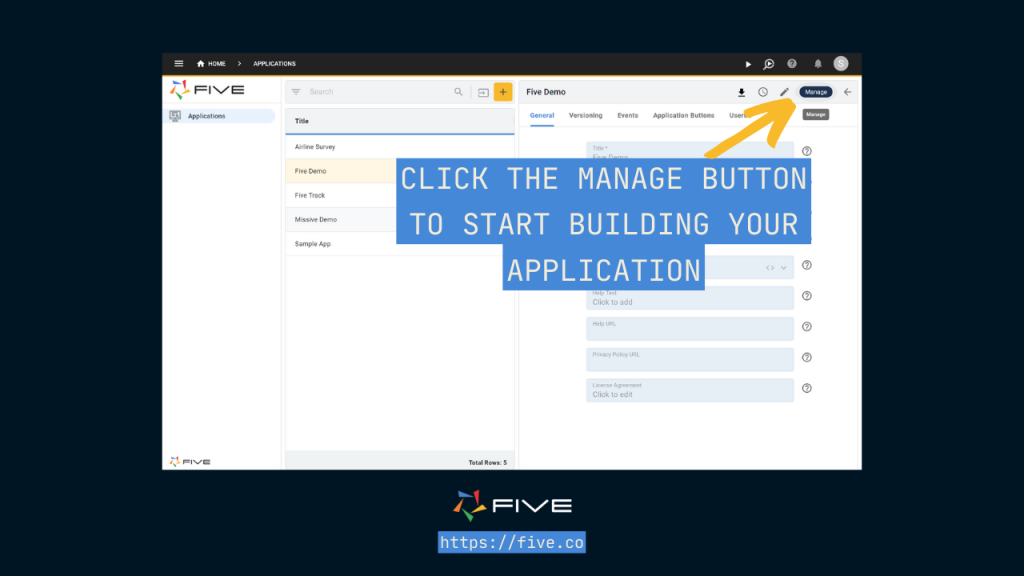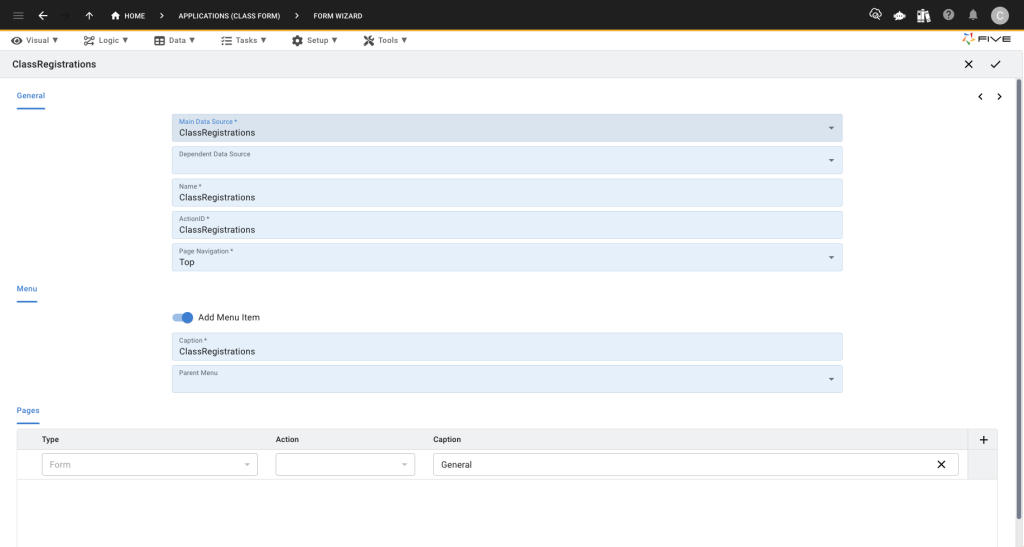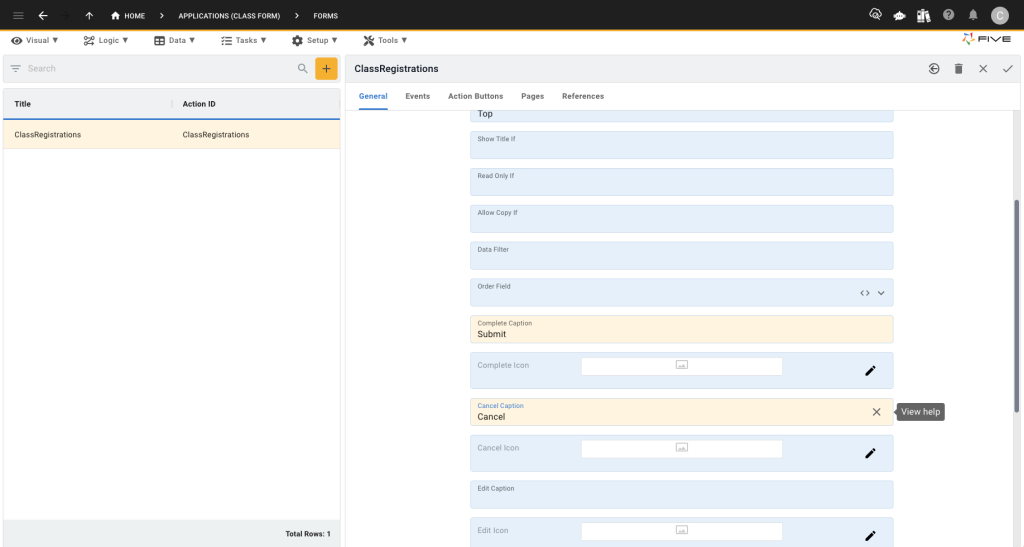Advanced Forms – Part 9: Display Types Hi…
Create a Class Registration Form in 3 Steps
How to Create a Class Registration Form
In this guide, we outline the steps necessary to create and launch a class registraion form using Five’s advanced form builder.
The process involves:
- Creating the database
- Designing the form
- Deploying the form
We will also cover securing the form with logins, authentication, and permissions, although this is an optional step.
What is a Class Registration Form?
A class registration form is an interface used to gather, store, and manage student or participant data for academic courses, workshops, or training programs.
These forms capture important information such as student details, course preferences, age groups, and payment information, which can be used for tracking, reporting, and organizing classes or educational programs.
Class registration forms can range from simple web forms to more complex systems integrated with a database and analytics tools.
Key Components of a Class Registration Form
- Web Forms: Online forms that participants fill out to submit registration details.
- Databases: Systems like MySQL, PostgreSQL, or MongoDB that store collected registration data in an organized manner. (Don’t worry if you’re not familiar—Five makes it easy.)
- Data Security: Measures to protect sensitive student data from unauthorized access and breaches.
- Analytics Tools: Software that allows users to query the database, generate reports, and visualize registration data.
- Dashboards: Interactive interfaces that provide real-time insights and trends on student registrations, course popularity, and attendance numbers.
Why a Traditional Form Builder Might Not Cut it
Class registration often involves managing relationships between various pieces of information, such as student details, course selections, and schedules.
Standard form builders typically struggle to handle these complex data structures, making it difficult to create a comprehensive view of each submission.
Security and compliance are also significant concerns, especially when handling sensitive student data like emergency contact information or payment details. Many off-the-shelf form builders lack the necessary security infrastructure to handle such data safely.
Furthermore, class registration forms often require advanced features, such as automatically assigning students to specific classes, calculating fees based on age groups or course loads, and tracking attendance. Many standard form builders have limited capabilities, making it challenging to perform these complex operations accurately and in real-time.
Lastly, the need for advanced reporting and analytics is essential in organizing educational programs. Institutions require comprehensive tools to analyze registration data, track class sizes, and generate detailed reports.
Most traditional form builders offer only basic reporting features that fall short of these needs.
Building a Class Registration Form With Five
Creating a class registration form in Five offers significant advantages over traditional form builders, making it ideal for those who need robust, secure, and analyzable participant data.
Unlike traditional form builders, which only store submitted data, Five allows you to directly connect your registration form to a database.
This connection enables you to query your database and generate visual representations of your data, making it easier to identify trends, track class sizes, and monitor student participation.
Most traditional form builders require exporting data to third-party tools for analysis, adding extra steps and the potential for errors.
While traditional form builders may suffice for very basic class registration tasks, they often struggle with large datasets or high submission volumes.
Five’s database-connected solution, on the other hand, is designed to handle substantial amounts of registration data efficiently, making it ideal for schools, universities, workshops, or any educational programs.
With Five, you can:
- Quickly deploy your registration form with a secure database.
- Build a user-friendly interface that protects sensitive data with login authentication.
Step 1: Database for Your Class Registration Form
To get started, sign up for free access to Five and create a new application by navigating to the Applications section and clicking the yellow plus button.
Create a New Application:
- Click the yellow plus button.
- Name your application (e.g., “Class Form”).

- Confirm by clicking the check icon in the upper right corner.
- Click on the blue Manage button to enter the development environment.

Create Database Tables:
- Go to Data > Table Wizard, a user-friendly interface for creating database tables.
- Name your table descriptively (e.g., “ClassRegistrations”).
- Add fields to your table using the plus button, specifying appropriate data types:
StudentName(Text): The student’s full name.StudentDOB(Date): The student’s date of birth to ensure they meet age or grade requirements.StudentContact(Text): The student’s contact information (phone number or email).ClassName(Text): The name of the class the student is registering for.ClassSchedule(Text): The time or date for the class.EmergencyContact(Text): The contact information of the student’s emergency contact (name, relationship, phone number).ConsentAgreement(Boolean): A checkbox for students to confirm consent to terms and conditions or waivers.

Save Your Database Table:
After adding all relevant fields, save your table by clicking the check icon in the upper right corner. Your MySQL database table is now ready to store class registration data.
Side Note:
This might seem more advanced than what you were expecting, but nothing worth having comes super easy. Five excels at building complete applications, which means you can actually expand your form into a fully-fledged application capable of more than a standard form builder.
Step 2: Designing the Class Registration Form
Next, navigate to Visual > Form Wizard in Five to design your class registration form.
Select Data Source:
In the Form Wizard’s General section, select the “ClassRegistrations” table you created as the main data source. This links your backend (database) with your frontend (form).

Finalize the Form:
Click the check icon in the upper right corner to complete the form creation. Your form is now ready and connected to your database.
Add Form Submit/Cancel Buttons:
Next, navigate to Visual, then select Forms and scroll down. Under Complete Caption, you can add your submit button (feel free to customize the text). You can also change the Cancel Caption. Remember to click the tick to save afterward.

Add Your URL:
Next, navigate to Setup, then select URL and add an item. Ensure it is lowercase. Also, select your form in the action field.

Step 3: Deploying the Class Registration Form
Deploy to Development:
Click the Deploy to Development button in the top right corner. This action opens your class registration form in a new browser tab, allowing you to preview it.
Once you run your application, your default URL will look something like this:https://control-default-classform-ryan.5au.dev/?reloadSchema=1a2756a9-e99f-43ca-95e6-b52317502f8b&inspect=false
Delete this URL section ?reloadSchema=1a2756a9-e99f-43ca-95e6-b52317502f8b&inspect=false and replace it with what you named your URL above.
For example, based on this demo, the new URL would be:https://control-default-classform-ryan.5au.dev/url/form
Enhance Your Form:
Consider adding features such as conditional logic to guide students through the registration process or automated emails confirming submission.
Securing Your Class Registration Form: Logins, Authentication, Permissions
One of Five’s added benefits is the ability to secure your class registration form with login protection, authentication, and permissions, ensuring only authorized users can access or modify data.
Here are the steps to add user roles and logins:
- Turn your application into a multi-user app by automatically adding a login screen.
- Create user roles with specific permissions. For example:
- Student Role: Can submit class registration forms.
- Admin Role: Can review registrations, assign students to classes, and access the dashboard summarizing all submissions.
Explore More Security Features:
Utilize Five’s documentation for detailed instructions on securing your class registration form with authentication and permissions to ensure only authorized users can access or modify data.
Custom URL Option:
To add a custom URL like classregistrationform.com, you’ll need to sign up for a paid plan of Five.
To learn more about Five and expand your form, check out some of our code-along articles.
Conclusion: Building a Class Registration Form
Building a class registration form with Five’s application development environment offers numerous advantages over traditional form builders.
The process involves three key steps: creating the database, designing the form, and deploying the web form. Five provides security features, including login protection, authentication, and user permissions, ensuring that your class registration form is secure and only accessible to authorized users.
By using Five, you can directly connect your class registration form to a database, enabling efficient data management and real-time analysis through custom charts and reports.
This capability allows you to easily track registrations, manage class assignments, and monitor student data effectively—tasks that are often cumbersome with traditional form builders that require exporting data to third-party tools.
With Five, you can enhance your class registration process, improve data security, and leverage analytical tools to gain insights, making it the superior choice for creating a comprehensive and efficient class registration form.


